17th century
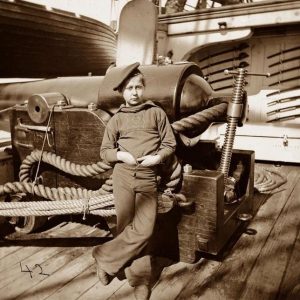 A while back, while looking at historical pictures, I came across one that bore an amazing resemblance to my grandson, Chris Petersen. I realize that a lot of people say that some people remind them of other people, but even my family agreed that this young man looked like Chris at that age. I have no idea who this boy is, or if he is related to Chris, because the picture doesn’t tell his name…just his occupation, which was quite interesting. The boy is, what is known as, a Powder Monkey. I had no idea what that was, and after doing some research on it, I’m thankful that powder monkey is not an occupation we have today, and thankful that my grandson never had the opportunity to be one. To me, it seems like a very dangerous occupation.
A while back, while looking at historical pictures, I came across one that bore an amazing resemblance to my grandson, Chris Petersen. I realize that a lot of people say that some people remind them of other people, but even my family agreed that this young man looked like Chris at that age. I have no idea who this boy is, or if he is related to Chris, because the picture doesn’t tell his name…just his occupation, which was quite interesting. The boy is, what is known as, a Powder Monkey. I had no idea what that was, and after doing some research on it, I’m thankful that powder monkey is not an occupation we have today, and thankful that my grandson never had the opportunity to be one. To me, it seems like a very dangerous occupation.
Powder boys were used during the 17th century on warships. A powder boy or “powder monkey” manned naval artillery guns as a member of a warship’s crew, primarily during the age of sailboats. His chief role was to carry gunpowder from the powder magazine in the ship’s hold to the artillery guns. Sometimes he carried bulk powder and other times he carried cartridges, to minimize the risk of fires and explosions. The function was usually fulfilled by boy seamen of 12 to 14 years of age. Powder monkeys were selected for the job for their speed and height. They needed to be short so they could not be seen, and could move more easily in the limited space between decks, while remaining hidden behind the ship’s gunwale, thereby keeping them from being shot by enemy ships’ sharp shooters. Some women and older men also worked as powder monkeys. I realize that this might have seemed like a good idea, but as a mom and grandma, I would be terribly worried if that were my boy on one of those ships.
While the Royal Navy first began using the term “powder monkey” in the 17th century, it was later used, and  continues to be used in some countries, to signify a skilled technician or engineer who engages in blasting work, such as in the mining or demolition industries. In such industries, a “powder monkey” is also sometimes referred to as a “blaster.” It seems that just about any occupation that carries the name “powder monkey” is a dangerous one. As to the boys who did this work on warships, well…their bravery is amazing. They must have see death around them. They knew the risks. Still, they saw a need, and knew that their contribution would help their country. They were patriots, and as with any soldier, they have my respect. They should never be forgotten, because they were soldiers too…in every way.
continues to be used in some countries, to signify a skilled technician or engineer who engages in blasting work, such as in the mining or demolition industries. In such industries, a “powder monkey” is also sometimes referred to as a “blaster.” It seems that just about any occupation that carries the name “powder monkey” is a dangerous one. As to the boys who did this work on warships, well…their bravery is amazing. They must have see death around them. They knew the risks. Still, they saw a need, and knew that their contribution would help their country. They were patriots, and as with any soldier, they have my respect. They should never be forgotten, because they were soldiers too…in every way.
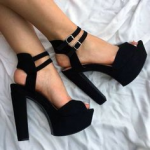
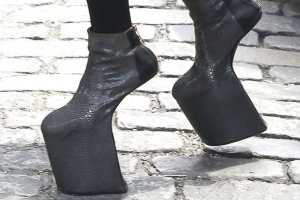 Most of my friends know that I love shoes. In fact, that is truly an understatement. I have shoes for every need and for every outfit. I have hiking shoes, sandals, shoes for jeans, boots…lots of boots, and of course, heels…of every color, height, and style from low heels to platform heels, and even funky heels. Yes, I love shoes. But there is a line that even I won’t cross.
Most of my friends know that I love shoes. In fact, that is truly an understatement. I have shoes for every need and for every outfit. I have hiking shoes, sandals, shoes for jeans, boots…lots of boots, and of course, heels…of every color, height, and style from low heels to platform heels, and even funky heels. Yes, I love shoes. But there is a line that even I won’t cross.
Over the centuries in many areas of the world, shoe style was really a show of status. And in some countries, the size of a woman’s foot was so important that women would stuff their feet into shoes that would fit a young child. Those women were so intent on making their feet small, that they would perform a procedure on them called foot binding. It is a crazy way of tying the toes in such a way, so as to make a point of the front of the foot. The foot was then bent almost in half to fit in a shoe for a young child. I think every woman would like her feet to be smaller, at least every woman who wears size seven or above, but foot binding is extreme.
I love platform heels, but some styles…both old and new, are ridiculous. When the platform is so high, and 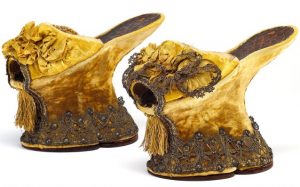
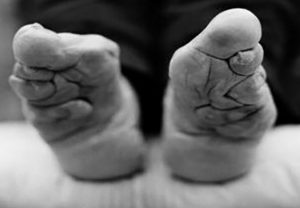
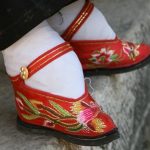 made of something with no give to it, or has no heel on it, the woman wearing the heel really can’t even walk by themselves. And believe me, I would need help too, and I’m used to platforms. It’s just that these aren’t platforms. No, they are stilts!! Platforms have been a tradition for a very long time in Europe, clear back to the 17th century, and then they were out of fashion until the 20th century. Really, it wasn’t until Ferragamo reintroduced them in the 1930s that platforms came back in style. In 2009, an exhibition was organized, with an accompanying catalog on the topic of these elevating shoes, titled “On A Pedestal: From Renaissance Chopines to Baroque Heels.” Chopines, which were also known as zoccoli or pianelle, are a platform shoe up to 20 inches high. Of course, those who wore them required the help of servants so that they didn’t fall flat on their face…in the name of fashion. The idea of chopines, besides being a fashion statement, was to protect the wearer’s clothes from street mud. Never mind the servant’s clothes, and really, why did they have to go out in the
made of something with no give to it, or has no heel on it, the woman wearing the heel really can’t even walk by themselves. And believe me, I would need help too, and I’m used to platforms. It’s just that these aren’t platforms. No, they are stilts!! Platforms have been a tradition for a very long time in Europe, clear back to the 17th century, and then they were out of fashion until the 20th century. Really, it wasn’t until Ferragamo reintroduced them in the 1930s that platforms came back in style. In 2009, an exhibition was organized, with an accompanying catalog on the topic of these elevating shoes, titled “On A Pedestal: From Renaissance Chopines to Baroque Heels.” Chopines, which were also known as zoccoli or pianelle, are a platform shoe up to 20 inches high. Of course, those who wore them required the help of servants so that they didn’t fall flat on their face…in the name of fashion. The idea of chopines, besides being a fashion statement, was to protect the wearer’s clothes from street mud. Never mind the servant’s clothes, and really, why did they have to go out in the 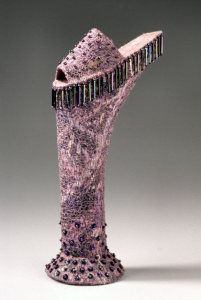
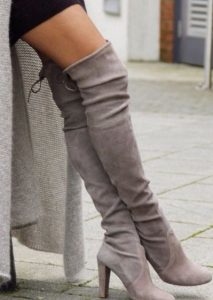 mud anyway? They were aristocrats, couldn’t someone just carry them on a platform chair, or run their errand for them. Whatever the case may be, I will not be buying a pair of these crazy stilt platforms, should they ever come into style again.
mud anyway? They were aristocrats, couldn’t someone just carry them on a platform chair, or run their errand for them. Whatever the case may be, I will not be buying a pair of these crazy stilt platforms, should they ever come into style again.
I do love my many styles of shoes, and my platforms are among the favorites, but I draw the line at about a 3 inch platform. Much more than that, and I not only have difficulty walking, but I end up taller than everyone around me, and for me that is just too odd. I am used to being one of the “wee ones,” as my niece Kellie Hadlock calls me, and that’s ok with me. I never wanted to be tall anyway. I’ll let my platforms make me look tall. I’m good with that!!

